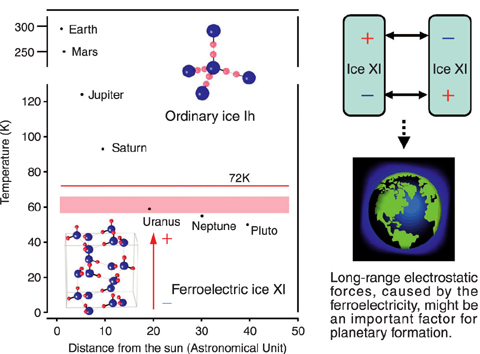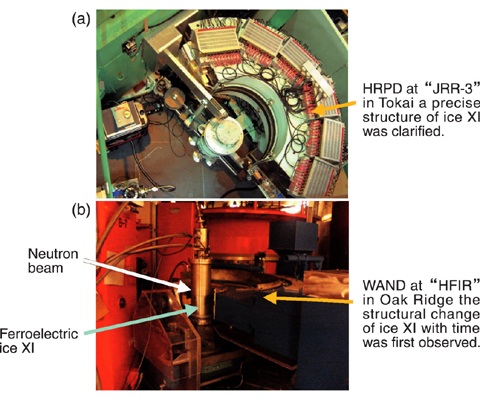
Fig.4-2

Fig.4-3
Neutrons are sensitive to hydrogen (H), and a neutron diffraction study gives us accurate information about H atoms. Recently, we made an imitation of the ice of cold space and measured neutron diffraction of the ice. We found that the position of hydrogen became ordered at the temperatures (below -200°C) of Uranus, Neptune and Pluto. H of the water molecule (H2O) has a positive charge. When H is ordered, ice polarizes to have a positive and negative end and becomes ferroelectric. Based on the neutron measurements, we propose that ferroelectric ice, named ice XI, exists in the universe (Fig.4-2).
In ordinary ice, named ice Ih, H is equally distributed around adjacent oxygen atoms. Ice Ih has no polarization. On the other hand, ice XI polarizes as indicated by the red arrow in Fig.4-2. Thus, the particles of ice XI have long-range electric attraction to each other. The small ice XI of several micrometers in solar nebula may grow quickly and attract electrons and ions. This special character of ice XI becomes a key that solves the mystery of planet formation and material evolution.
The structure of ice was examined in detail by our neutron diffractometer (Fig.4-3(a)) in Tokai. The structural changes with time were investigated by a high intensity diffractometer (Fig.4-3(b)) at a high flux reactor of the Oak Ridge National Laboratory. From the time-resolved measurements, we found the temperature conditions for the transformation of the largest fraction of ice into ice XI using the lowest level of impurity dopant. The red area in Fig.4-2 represents temperatures (57-66 K) at which ice Ih is able to transform to ice XI. Once ice XI is formed at this temperature condition, it remains in this form at any temperature below 72 K. The ice Ih with dopant transforms to ice XI in one week. The movement phenomenon observed in this hydrogen over the course of one week is estimated to take about 10,000 years in ice without the catalyst. Therefore, ice in outer space which anneals at temperatures of 57-66 K and is kept below 72 K for 10,000 years becomes ferroelectric ice XI.
This research suggests that future telescopes will find huge ferroelectric ice in space. We expect that there is ferroelectric ice XI on Uranus, Neptune, and Pluto, their satellites, and icy objects in the outer solar system. A neutron study concerning ice forms inside these objects is underway.